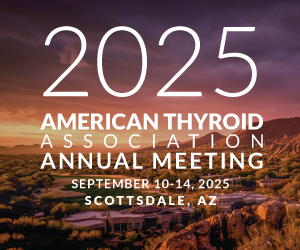October 16, 2013 — The American Thyroid Association (ATA) recommends against the routine use of radioactive iodine after surgery to remove the thyroid in patients with low-risk papillary thyroid cancer (PTC). Yet more than 30% of these patients receive radioactive iodine (RAI) treatment in the U.S. A new study presented at the upcoming annual meeting of the ATA finds that overutilization of RAI is more common in regions of the country where people have worse access to health care.
J. Marti and colleagues from Beth Israel Medical Center and Memorial Sloan-Kettering Cancer Center, New York, NY analyzed more than 13,000 cases of very low risk classical PTC across the U.S. in which patients underwent total thyroidectomy. They report that patterns of RAI use in these patients vary dramatically. Over a 19-year period, the proportion of patients who received RAI ranged from 30-36%.
In a presentation entitled “Overutilization of RAI for Very Low Risk Thyroid Cancer Is Most Frequent in Regions with Poorer Healthcare Access,” the researchers describe a composite of socioeconomic factors used to rank the different geographic regions that together are associated with higher use of RAI. These factors include significantly lower levels of income, education, and white collar employment, and higher levels of uninsured, non-English speaking, and poor persons. The people living in these regions have poorer access to health care and, likely, to experienced specialists.
This study will be presented as part of an oral presentation delivered at the 83rd Annual Meeting of the American Thyroid Association, October 16-20, 2013, in San Juan, Puerto Rico.
“Radioiodine therapy has potential toxicity and financial costs, yet a substantial number of low risk thyroid cancer patients receive this therapy despite little to no chance of benefit,” says Ronald J. Koenig, M.D., Ph.D., Program Committee Co-Chair, and Professor, Department of Internal Medicine, University of Michigan Medical Center, Ann Arbor. “In order to minimize the overuse of RAI, it is first necessary to identify the factors that lead to this overuse. The study by Marti and colleagues helps to do this, identifying socioeconomic factors that correlate with RAI overuse. Importantly, their data suggest the problem may be inadequate access to appropriate specialists, a problem that should be remediable.”
About the ATA
The American Thyroid Association (ATA) is the leading worldwide organization dedicated to the advancement, understanding, prevention, diagnosis and treatment of thyroid disorders and thyroid cancer. ATA is an international individual membership organization with over 1,700 members from 43 countries around the world. Celebrating its 90th anniversary, ATA delivers its mission through several key endeavors: the publication of highly regarded monthly journals, THYROID, Clinical Thyroidology (CT), VideoEndocrinology and CT for Patients; annual scientific meetings; biennial clinical and research symposia; research grant programs for young investigators, support of online professional, public and patient educational programs through www.thyroid.org; and the development of guidelines for clinical management of thyroid disease. Visit www.thyroid.org for more information.
Media Contact
Bobbi Smith
Executive Director of the American Thyroid Association
Email: thyroid@thyroid.org



